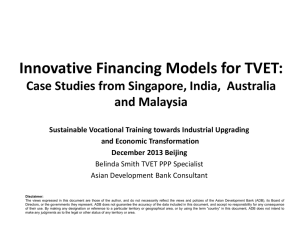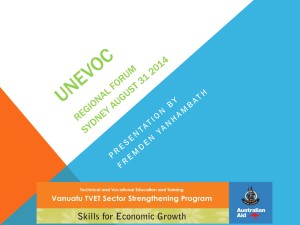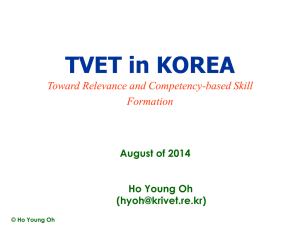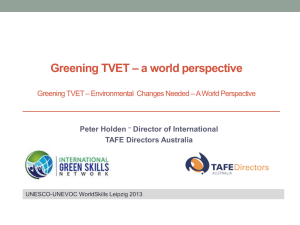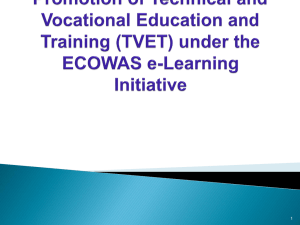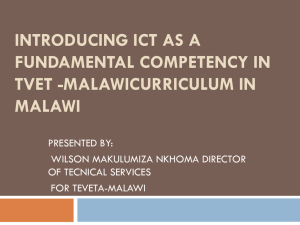Designing Financing System for Lifelong Learning
advertisement
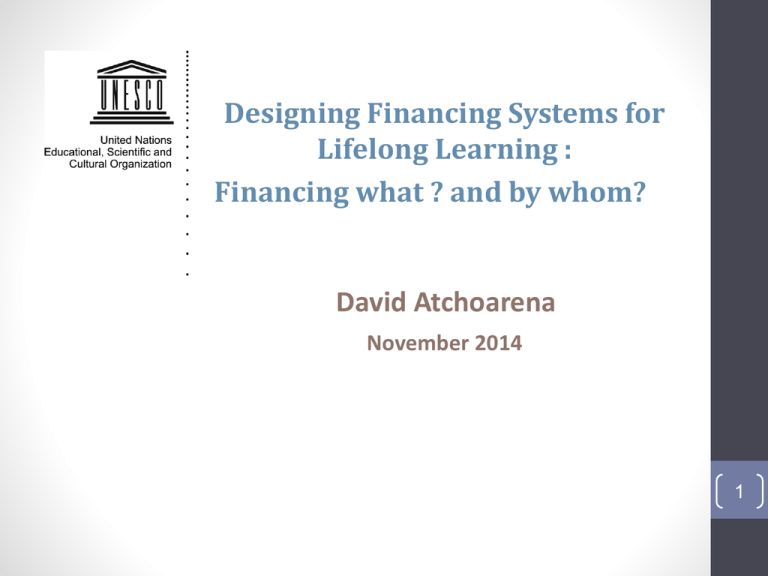
Designing Financing Systems for Lifelong Learning : Financing what ? and by whom? David Atchoarena November 2014 1 TVET Funding: Key building block of TVET reform During last decade, TVET reforms aimed at responding to contextual factors and were driven by following rationales: • Economic growth rationale (mainly): Shift from a supplydriven mode to one that is driven by economic demand • Social equity rationale (increasingly): Expand to include social objective that have sought to expand access to TVET learning opportunities especially for marginalized groups • Sustainable development rationale (more recent): broader objective related to sustainability of societies, green economies and lifelong learning 2 Prevailing TVET funding models: Meeting the economic and social equity rationales • Funding mechanisms and methodologies for allocation and use were considered as integral parts of TVET steering. • Diversified financing of TVET was considered crucial for a successful transition from policy formation to long-term policy implementation. • Financing policies were expected to ensure both the stability of funding needed to develop the capacity for policy implementation as well as the level of financing to improve TVET outcomes. • Key examples of policy measures that have been used include: the establishment of sustainable funding source: Training funds over sixty countries mostly in Africa, Latin America and Europe (Johansen, 2009 & CEDEFOP, 2008) the improvement of effectiveness, efficiency, equity and accountability of TVET funding: Performance-based formula in Scotland Increase TVET attractiveness through funding: TVET in Tertiary education in Chile 3 Typology of training funds • (i) pre-employment training fund: build national training capacities and increase training provision to meet labour market needs. For example, SENAI in Brazil trains 2.8 million people per annum and has accounted for over 30 million trainees since its creation (Source: UNESCO, 2014) • (ii) enterprise training fund: increase the productivity and competitiveness of firms by raising the skills of workers. The Special Training Contracts Fund in Morocco supports enterprises in defining their skills needs and in investing in employees training. • (iii) equity training fund: raise the incomes of disadvantaged groups by providing skills development opportunities. An example is the Cambodian Training Fund which was established to support community-based training initiatives in particular in rural areas (Source: UNESCO, 2013). Source: Johansen 2009 4 Other important Funding Sources • Employment Funds (Tunisia, Algeria) • Poverty reduction Funds (Laos) • Social Funds (Egypt) 5 Lifelong Learning at the forefront of the international development discourse Post-2015 agenda aims at achieving inclusive lifelong learning for all Muscat Agreement Report of the High-Level Open Working Panel of Group on Eminent Sustainable Persons on Development the post-2015 Goals Development Agenda Forthcoming UN Secretary General Report 6 Main features of lifelong learning and implications Life-long Life-wide Learning and learner centered People continue learning throughout their lives, not just in informal ways but also in formal and non-formal settings. Learning in many different settings Shift of perspective from ‘education’ to ‘learning’ Smooth progression, with multiple access and exit points, pathways and transitions Assessment and recognition of learning occurring outside the formal education system important Learner has greater choice in learning opportunities and options but also greater responsibility Source: Hans G. Schuetze (2007) Individual Learning Accounts and other models of financing lifelong learning, International Journal of Lifelong Education, 26:1, 5-23 7 Different financing models for LLL systems Complementary Coordinated Integrated • Single purpose of programme systems • Unconnected to and complementing others • Multiple systems for different activities and/or populations • Certain degree of consistency and level of coordination • Single financing system for all lifelong learning activities 8 Source: Hans G. Schuetze (2007) Individual Learning Accounts and other models of financing lifelong learning, International Journal of Lifelong Education, 26:1, 5-23 Promising approaches for the financing of LLL Learner-centred Individual Learning Accounts Individual entitlements Loan schemes Social security schemes Financing instruments reflecting this focus • Savings ILA (ex. Austria) • Training Vouchers (ex. Italy) • Entitlements to training (ex. Australia) • Time credit (CPF, France) • Fixed instalments loans (ex. Career development loans, UK) • Income contingent loans (ex. Australia, expanding to skills training) 9 • Ex. Malaysia Employees Provident Fund Promising approaches for the financing of LLL Life-long and life-wide Financing of recognition and validation schemes • Right to validation schemes, possibly financed. Certific, Brazil, National system of certification of Labour competences, Chile • Documentation tools of qualifications, skills and learning experiences. Ex. Shanghai Academy Credit Transfer and Accumulation Bank for Lifelong Education, Europass, Online Badges. Financing schemes enabling smooth progression Other services promoting access to LLL and progression • Guidance (France) • Training leaves (can be combined with other financing incentives) 10 UNESCO’s strands of work Policy review and capacity building • UNESCO guidelines for TVET policy review: 15 conducted and ongoing reviews • Capacity building programmes in Malawi, Madagascar, Benin, Afghanistan Publications • UNESCO publication “Unleashing TVET potential” (forthcoming): Review of international experience in funding TVET • UNESCO publication “BRICS Education for the future”: Review of BRICS skills development strategies Normative work • Revision of the 2001 TVET Recommendation: Defining key principles • Examining LLL from a right perspective Research • UNESCO-UNEVOC: Reviewing Return on investment in TVET (Economic, social and sustainability) • Pole de Dakar & TVET Section: Exploring private investment in skills development through LFS and HHS data 11 Thank you ! 12

